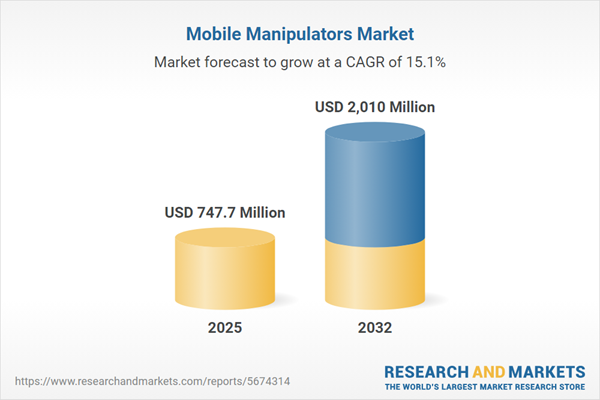Speak directly to the analyst to clarify any post sales queries you may have.
The Mobile Manipulators Market is redefining automation by enabling robotic intelligence that seamlessly combines movement and precision across diverse industrial environments. Leading enterprises are strategically deploying these adaptable systems to boost operational efficiency while enhancing safety and resilience.
Market Snapshot: Mobile Manipulators Market Growth Overview
The Mobile Manipulators Market grew from USD 653.92 million in 2024 to USD 747.70 million in 2025. The market is set to achieve a CAGR of 15.10%, reaching USD 2.01 billion by 2032.
Mobile manipulators blend autonomous vehicles with advanced articulated arms, empowering organizations to automate increasingly complex tasks while reducing labor costs and risks.Scope & Segmentation
This report delivers a comprehensive analysis of the current landscape, future outlook, and critical drivers shaping the mobile manipulators industry. It accounts for the interplay between technology, regional dynamics, and end-user demands.
- Component: Hardware (includes control systems, end effectors, locomotion systems, robotic arms, sensors), Services (integration services, maintenance and support, training), Software (control, automation, data analysis, management platforms).
- Automation Level: Fully autonomous and semi-autonomous solutions supporting a range of operational environments.
- Module Type: Grip and manipulation, mobility and navigation are central to addressing both delicate and large-scale logistics functions.
- End User Industry: Segments analyzed include agriculture, automotive, construction, consumer goods and retail, food and beverage, healthcare, hospitality, and logistics and warehouse.
- Application: Machine tending, material transportation, pick and place operations, and quality inspections within varied industrial workflows.
- Distribution Channel: Both direct sales and distributor or dealer channels are assessed for impact on procurement and support strategies.
- Regional Coverage: Americas, Europe/Middle East/Africa, and Asia-Pacific, including deep dives into countries such as United States, Germany, China, Japan, and emerging markets across each region.
- Key Companies: Coverage includes ABB Ltd., Boston Dynamics, Omron Corporation, Kuka AG, FANUC Corporation, and additional prominent manufacturers, integrators, and solutions providers influencing the competitive landscape.
Key Takeaways: Strategic Insights for Decision-Makers
- Recent advances in sensor integration, artificial intelligence, and control architecture are accelerating mobile manipulator adoption across large manufacturing and logistics sectors.
- Industry leaders are prioritizing modular, scalable hardware and interoperable software solutions to swiftly adapt automation investments for evolving business models and workforce realities.
- Collaborative robotics platforms are recalibrating safety and productivity standards, enabling close human-robot interaction while mitigating the need for extensive safety barriers.
- The growing emphasis on sustainability is driving innovation in energy-efficient drive systems and the use of environmentally conscious materials within key robotic subsystems.
- Differentiation in competitive strategy is rooted in comprehensive service portfolios—such as global training academies and predictive maintenance systems—integrated with transparent support structures.
- Global coverage ensures actionable intelligence tailored to unique regional regulation, infrastructure maturity, and sector-specific challenges.
Tariff Impact
The implementation of new United States tariffs in 2025 has added complexity to the mobile manipulator supply chain. Producers and integrators are responding by diversifying sourcing strategies, strengthening domestic partnerships, and accelerating localized assembly to navigate elevated import costs. Service providers are leveraging these shifts with bundled offerings that help offset capital expenditures and maintain technology adoption rates under changing fiscal conditions.
Methodology & Data Sources
This study utilizes a dual-method approach, incorporating primary interviews with executives and integrators, as well as secondary intelligence from corporate filings, patents, and sectoral whitepapers. Field visits and observational studies enhance the accuracy of integration workflows, while robust data triangulation resolves information gaps and validates qualitative and quantitative findings.
Why This Report Matters
- Enables C-level executives to benchmark current automation investments against global peers and identify optimal expansion strategies based on segment-specific insights.
- Supports procurement and supply chain leads in assessing the effect of geopolitical changes—such as new tariffs—and highlights effective responses to shifting cost structures.
- Delivers actionable intelligence for technology planning, training, and workforce development across organizations committed to operational excellence and sustainability.
Conclusion
Mobile manipulators are reshaping automation standards across industries, driving a shift toward agile, precise, and adaptable solutions. This report provides stakeholders with the verified intelligence required for strategic alignment and sustained growth in a rapidly evolving market environment.
Additional Product Information:
- Purchase of this report includes 1 year online access with quarterly updates.
- This report can be updated on request. Please contact our Customer Experience team using the Ask a Question widget on our website.
Table of Contents
3. Executive Summary
4. Market Overview
7. Cumulative Impact of Artificial Intelligence 2025
Companies Mentioned
The companies profiled in this Mobile Manipulators market report include:- ABB Ltd.
- Agility Robotics
- Asratec Corporation
- Autonox Robotics GmbH
- Beijing Geekplus Technology Co., Ltd.
- Boston Dynamics, Inc.
- Collaborative Robotics Inc.
- Comau S.p.A.
- Continental AG
- Diligent Robotics, Inc.
- F&P Robotics AG
- FANUC Corporation
- Groupe ECA
- inVia Robotics, Inc.
- Kawasaki Heavy Industries, Ltd.
- Kuka AG
- Mitsubishi Electric Corporation
- Mujin Corp.
- Neobotix GmbH
- Omron Corporation
- PAL ROBOTICS SL.
- Panasonic Holdings Corporation
- Rainbow Robotics
- Rethink Robotics, Inc.
- Rockwell Automation, Inc.
- SCIO Automation GmbH
- Staubli International AG
- Teradyne, Inc.
- Toshiba Corporation
- United Robotics Group GmbH
- Zebra Technologies Corporation
Table Information
| Report Attribute | Details |
|---|---|
| No. of Pages | 181 |
| Published | November 2025 |
| Forecast Period | 2025 - 2032 |
| Estimated Market Value ( USD | $ 747.7 Million |
| Forecasted Market Value ( USD | $ 2010 Million |
| Compound Annual Growth Rate | 15.1% |
| Regions Covered | Global |
| No. of Companies Mentioned | 32 |









